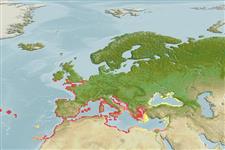>
Blenniiformes (Blennies) >
Blenniidae (Combtooth blennies) > Salariinae
Etymology: Coryphoblennius: Greek, koryphe = summit + Greek, belnnios = mucus (Ref. 45335).
More on author: Linnaeus.
Environment: milieu / climate zone / depth range / distribution range
экология
морской демерсальный. Subtropical; 52°N - 20°N, 19°W - 42°E
Eastern Atlantic: along the coasts of western England and the British Channel, Spain, Portugal, France, Morocco, Madeira , Canary Islands; Mediterranean Sea, Sea of Marmara, and the Black Sea.
Size / Вес / Возраст
Maturity: Lm ? range ? - ? cm
Max length : 7.6 cm SL самец/пол неопределен; (Ref. 5298)
Facultative air-breathing (Ref. 126274); Intertidal (Ref. 31184), found on the wave-battered rocky shores (Ref. 5298). May remain out of water under rocks and seaweeds (Ref. 31184). Omnivorous; feed mainly on copepods and ostracods as juveniles and shift to diet of algae as adults (Ref. 94105). Breathe air when out of water (Ref. 31184). Juveniles in small tide pools (Ref. 41018). Oviparous. Eggs are demersal and adhesive (Ref. 205), and are attached to the substrate via a filamentous, adhesive pad or pedestal (Ref. 94114). Larvae are planktonic, often found in shallow, coastal waters (Ref. 94114). Territories protected by males include depressions, crevices or piddock holes (Ref. 5981).
Life cycle and mating behavior
Maturities | размножение | Spawnings | Egg(s) | Fecundities | личинки
Distinct pairing (Ref. 205). During mating, the male fans the nest as if cleaning and ventilating the area. Males release sperm during periodic quivers to fertilize eggs in the nest much like other blennies (Ref. 55747). Males guard the egg-masses of various females (Ref. 5981).
Bath, H., 1990. Blenniidae. p. 905-915. In J.C. Quero, J.C. Hureau, C. Karrer, A. Post and L. Saldanha (eds.) Check-list of the fishes of the eastern tropical Atlantic (CLOFETA). JNICT, Lisbon; SEI, Paris; and UNESCO, Paris. Vol. 2. (Ref. 5298)
Статус Красного Списка МСОП (Ref. 130435)
Угроза для людей
Harmless
Использование человеком
рыболовство: интереса не представляет
дополнительная информация
инструменты
Специальные отчеты
Скачать в формате XML
ресурсы в Интернет
Estimates based on models
Preferred temperature (Ref.
123201): 12.5 - 20.8, mean 18.6 °C (based on 504 cells).
Phylogenetic diversity index (Ref.
82804): PD
50 = 1.0000 [Uniqueness, from 0.5 = low to 2.0 = high].
Bayesian length-weight: a=0.00741 (0.00335 - 0.01640), b=3.02 (2.83 - 3.21), in cm total length, based on LWR estimates for this (Sub)family-body shape (Ref.
93245).
Trophic level (Ref.
69278): 2.3 ±0.0 se; based on diet studies.
устойчивость к внешним воздействиям (Ref.
120179): высокий, минимальное время удвоения популяции до 15 месяцев (Preliminary K or Fecundity.).
Fishing Vulnerability (Ref.
59153): Low vulnerability (10 of 100).
Nutrients (Ref.
124155): Calcium = 185 [37, 627] mg/100g; Iron = 1.71 [0.63, 5.45] mg/100g; Protein = 2.69 [0.00, 6.44] %; Omega3 = 0.285 [0.119, 0.650] g/100g; Selenium = 13.7 [2.6, 45.4] μg/100g; VitaminA = 23 [6, 85] μg/100g; Zinc = 1.61 [0.82, 3.32] mg/100g (wet weight);
